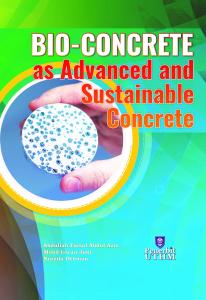BIO-CONCRETE as Advanced and Sustainable Concrete
Synopsis
High-performance concrete is frequently used in construction practice, not only because of its high-strength qualities, but also because of its high resistance to other external influences. Therefore, many studies have been performed to improve concrete properties. There are various methods for improving concrete properties, and one of them is by employing bacteria in concrete. Bacteria play an important role in bio-concrete by promoting deterioration in porous materials, improving sand properties, sealing the concrete porosity, and enhancing the durability of building materials. Mineral precipitation that results from metabolic activities of some microorganisms has emerged as a new research area for construction materials to improve the overall properties of concrete. These bacteria can precipitate calcium carbonate (CaCO3) by the production of urease enzyme. The precipitation of calcium carbonate crystals occurs by heterogeneous nucleation on bacteria cell walls. Super-induced CaCO3 precipitation has been proposed as an alternative and environmentally friendly crack repair technique. Microbial carbonate precipitation decreases the permeation properties of the concrete. Hence, a deposition of a CaCO3 layer on the surface of bacteria in concrete results in decreased water absorption and porosity. In addition, bio-concrete technology represents one of the biological CO2 sequestration applications specially in bio-foamed concrete, which has high level of pores. Acceleration of carbonation process under extreme pH and anaerobic condition of bio-concrete takes place due to the bacterial enzymes reaction carbonic anhydrase (CA) and urease which acts to precipitate CaCO3 into concrete pores.
Downloads
References
Abdeen, F. R., Mel, M., Jami, M. S., Ihsan, S. I., & Ismail, A. F. (2016). A review of chemical absorption of carbon dioxide for biogas
upgrading. Chinese Journal of Chemical Engineering, 24(6), 693-702.
Abed, Z. M., Jaber, A. A., Ghaeb, H. O., & Hasan, A. M. (2022). Effect of Different Conditions of Carbon Dioxide Curing in Cement–Based Composites (On Review). Iraqi Journal of Civil Engineering, 15(1), 10-17.
Alshalif, A. F., Juki, M. I., Othman, N., Al-Gheethi, A. A., & Khalid, F. S. (2019). Improvement of mechanical properties of bio-concrete using Enterococcus faecalis and Bacillus cereus. Environmental Engineering Research, 24(4), 630-637.
Al-Thawadi, S. M. (2011). Ureolytic bacteria and calcium carbonate formation as a mechanism of strength enhancement of sand. J. Adv. Sci. Eng. Res, 1(1), 98-114.
Aminu, M. D., Nabavi, S. A., Rochelle, C. A., & Manovic, V. (2017). A review of developments in carbon dioxide storage. Applied Energy, 208, 1389-1419.
Bai, J., Wild, S., & Sabir, B. B. (2002). Sorptivity and strength of aircured and water-cured PC–PFA–MK concrete and the influence
of binder composition on carbonation depth. Cement and Concrete Research, 32(11), 1813-1821.
Bertos, M. F., Simons, S. J. R., Hills, C. D., & Carey, P. J. (2004). A review of accelerated carbonation technology in the treatment of cement-based materials and sequestration of CO2. Journal of hazardous materials, 112(3), 193-205.
Chang, C. F., & Chen, J. W. (2006). The experimental investigation of concrete carbonation depth. Cement and Concrete Research,
(9), 1760-1767. De Ceukelaire, L., & Van Nieuwenburg, D. (1993). Accelerated carbonation of a blast-furnace cement concrete. Cement and concrete research, 23(2), 442-452.
Dhir, R. K., Limbachiya, M. C., McCarthy, M. J., & Chaipanich, A. (2007). Evaluation of Portland limestone cements for use in concrete construction. Materials and structures, 40(5), 459-473.
Fulke, A. B., Mudliar, S. N., Yadav, R., Shekh, A., Srinivasan, N., Ramanan, R., & Chakrabarti, T. (2010). Bio-mitigation of CO2, calcite formation and simultaneous biodiesel precursors production using Chlorella sp. Bioresource technology, 101(21), 8473-8476.
Galan, I., Andrade, C., Mora, P., & Sanjuan, M. A. (2010). Sequestration of CO2 by concrete carbonation. Environmental science & technology, 44(8), 3181-3186.
Gao, L., Fang, M., Li, H., & Hetland, J. (2011). Cost analysis of CO2transportation: case study in China. Energy Procedia, 4, 5974-5981.
Huppert, H. E., & Neufeld, J. A. (2014). The fluid mechanics of carbon dioxide sequestration. Annu. Rev. Fluid Mech, 46(1), 255-272.
Idi, A., Md Nor, M. H., Abdul Wahab, M. F., & Ibrahim, Z. (2015). Photosynthetic bacteria: an eco-friendly and cheap tool for bioremediation. Reviews in Environmental Science and Bio/ Technology, 14(2), 271-285.
Jang, J. G., Kim, G. M., Kim, H. J., & Lee, H. K. (2016). Review on recent advances in CO2 utilization and sequestration technologies in cement-based materials. Construction and Building Materials, 127, 762-773.
Jaya, P., Nathan, V. K., & Ammini, P. (2019). Characterization of marine bacterial carbonic anhydrase and their CO2 sequestration abilities based on a soil microcosm. Preparative Biochemistry & Biotechnology, 49(9), 891-899.
Jiang, J., Lu, Z., Niu, Y., Li, J., & Zhang, Y. (2016). Study on the preparation and properties of high-porosity foamed concretes based on ordinary Portland cement. Materials & Design, 92, 949-959.




